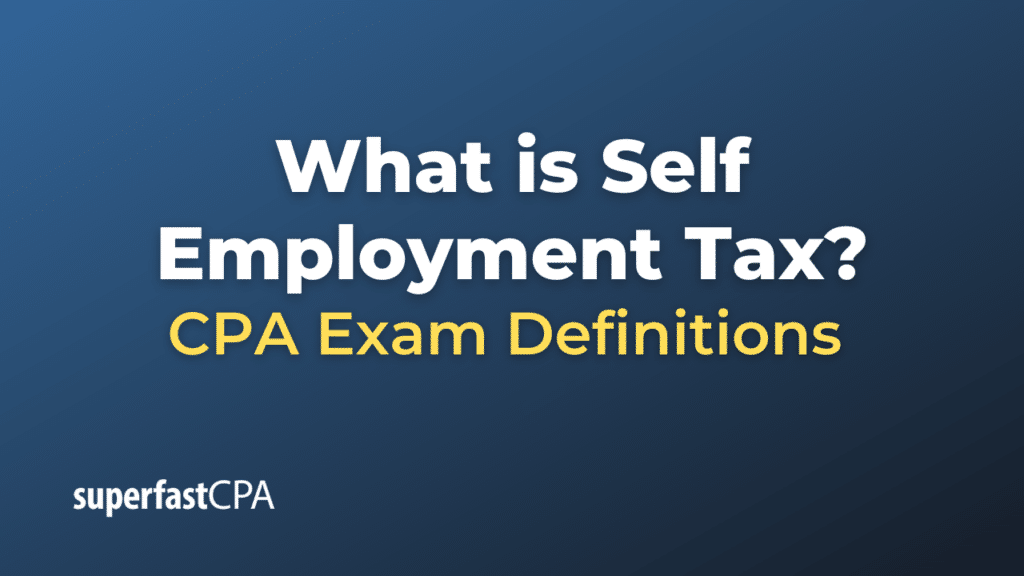Self Employment Tax
Self-employment tax refers to the taxes that self-employed individuals in the U.S. are required to pay to cover their Social Security and Medicare obligations. Because self-employed individuals don’t have employers to withhold these taxes from their paychecks (or to pay a portion of them, as happens with traditional employees), they’re responsible for both the employer and employee portion of these taxes.
Here’s a breakdown:
- Social Security Tax: This tax funds the Social Security program, which provides benefits for retirees, the disabled, and the families of retired, disabled, or deceased workers.
- Medicare Tax: This tax funds the Medicare program, a health insurance program for the elderly and some younger people with disabilities.
For traditional employees, the Social Security and Medicare taxes are split between the employee and the employer. Each pays:
- 6.2% for Social Security (on the first $142,800 of wages in 2021; this amount is subject to change each year)
- 1.45% for Medicare (with no income cap)
However, for self-employed individuals:
- They pay the combined employee and employer amount, which totals to 12.4% for Social Security (on the first $142,800 of net earnings in 2021) and 2.9% for Medicare (on all net earnings with no limit).
- Additionally, there’s an additional 0.9% Medicare tax on earnings that exceed a threshold amount, which is based on the individual’s filing status (e.g., $200,000 for single filers in 2021).
The good news for the self-employed is that they can deduct the employer-equivalent portion (which is half of the self-employment tax) when calculating their adjusted gross income on their tax return. This only affects income tax, not the net earnings or the amount of self-employment tax itself.
Self-employed individuals typically pay these taxes by making estimated tax payments throughout the year. It’s essential to keep thorough records and perhaps work with a tax professional to ensure that all tax obligations are met.
Example of Self Employment Tax
Sarah is a freelance graphic designer who works from her home office. In 2021, after deducting all her business expenses, Sarah’s net earnings from self-employment amount to $60,000.
Calculating Sarah’s Self-Employment Tax:
- Determine the taxable amount : Sarah needs to pay self-employment tax on 92.35% of her net earnings (because she can deduct 7.65%, which is half of the 15.3% total rate, from her earnings).
So, 92.35% of $60,000 = $55,410
- Calculate the Social Security tax: The Social Security tax rate for self-employed individuals is 12.4%. However, it’s only applicable to the first $142,800 (for 2021) of net earnings. Since Sarah’s taxable earnings are $55,410, which is below this threshold:
Social Security tax = 12.4% of $55,410 = $6,870.04
- Calculate the Medicare tax: The Medicare tax rate for self-employed individuals is 2.9%, with no cap on earnings (for the base amount).
Medicare tax = 2.9% of $55,410 = $1,606.89
Sarah’s total self-employment tax is $6,870.04 (Social Security) + $1,606.89 (Medicare) = $8,476.93
- Income tax deduction : Sarah can deduct half of her self-employment tax ($8,476.93 / 2 = $4,238.47) from her net earnings when calculating her adjusted gross income for income tax purposes. This doesn’t reduce the self-employment tax she owes, but it will reduce her overall income tax.
In this example, based on her net earnings of $60,000, Sarah owes $8,476.93 in self-employment tax for the year 2021. She should make estimated tax payments throughout the year to cover this amount and any income tax she owes. It would be wise for Sarah to consult a tax professional to ensure she’s taking advantage of all applicable deductions and making accurate payments.













